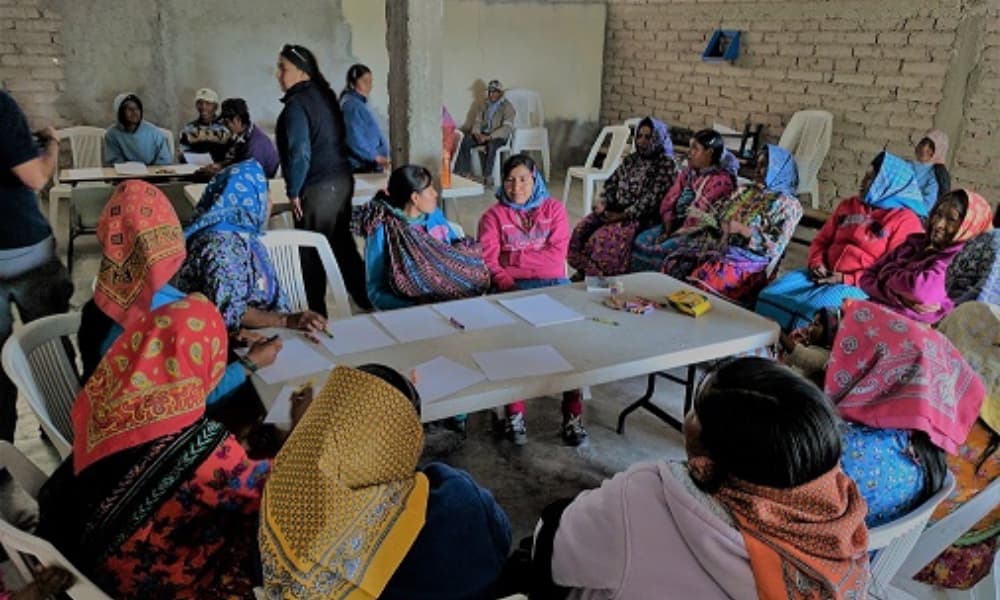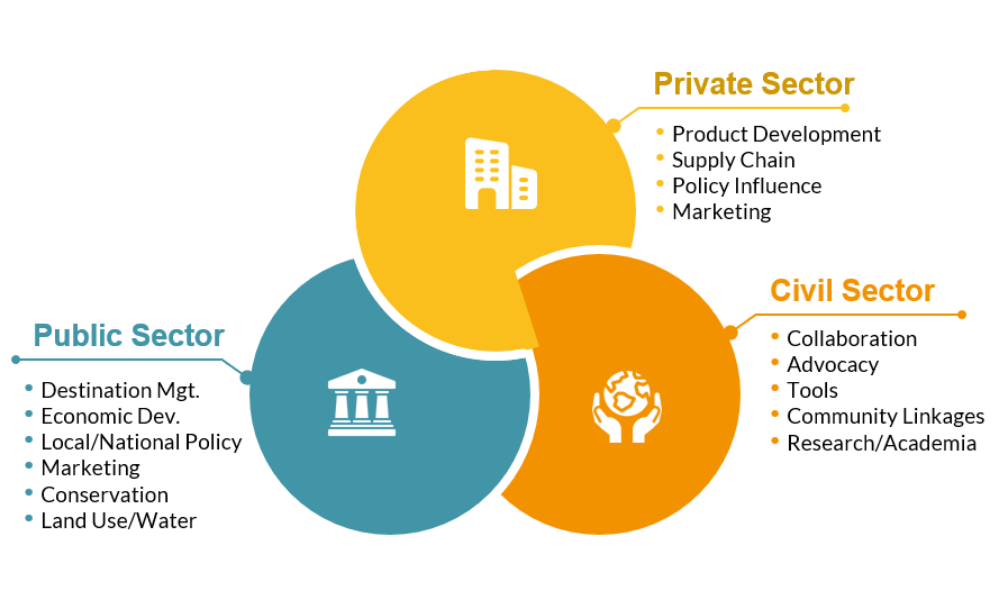Destination Stewardship Report – Spring 2023 (Volume 3, Issue 3)
This post is from the Destination Stewardship Report (Spring 2023, Volume 3, Issue 3), a publication that provides practical information and insights useful to anyone whose work or interests involve improving destination stewardship in a post-pandemic world.

A group of women in traditional clothing gather around a table to discuss tourism initiatives. [Photo courtesy of Mauricio Miramontes]
Building a community-centered destination stewardship initiative
Care for communities that make up the fabric of destinations is critical. But how? A destination stewardship approach can help tourism stakeholders – including community members – create their shared future in a collaborative and mutually beneficial way. Samantha Bray, PhD candidate at the University of Waterloo, shares her expertise. This post was originally published on the Center for Responsible Travel’s website.
What Does Destination Stewardship Mean and Why Does It Matter?
Translating the concept of destination stewardship to action requires a structure that supports bringing all of the stakeholders around the table. It also requires giving them a real voice in tourism planning, policy, and management.
While there are many structural models that can facilitate a destination stewardship approach, in this post we will be exploring the concept and importance of destination stewardship and formation and mobilization of destination stewardship councils.
Destination stewardship is defined by the Global Sustainable Tourism Council as “a process by which local communities, governmental agencies, NGOs, and the tourism industry take a multi-stakeholder approach to maintaining the cultural, environmental, economic, and aesthetic integrity of their country, region, or town.” It is about protecting the very qualities that make a place first and foremost a wonderful place to live, with the added benefit of being a wonderful place to visit.
This is important because a healthy and happy community is needed to support a healthy and happy tourism industry long-term. For too long, tourism development in the name of financial benefit for a few has occurred at the expense of the people who actually spend every day in a place. Their natural and cultural assets, and even their very neighborhoods, become commodified to the point where the community itself cannot enjoy them. Their fundamental ways of life are degraded in the name of more people, more money, more tourism.
Of course, profit is an essential “leg” of the triple bottom line stool of “people, planet, profit.” The World Travel & Tourism Council reported tourism accounted for 10.3% of global GDP and 330 million jobs (1 in 10) around the world in 2019. Tourism has countless benefits for destination communities, businesses, and travelers. However, we need to use the post-Covid “tourism reset” opportunity to take a hard look at the way things have been done and consider how we can do them better. (We also need better metrics, which is something CREST and colleagues at the Future of Tourism Coalition and others are working on.)
What we can do now is shift our mindsets to a stewardship approach. Pre-Covid, there was an escalating movement of dissatisfaction among residents of many destinations who had simply had enough. They felt they were not being listened to and that their wants and desires were not part of the tourism development and management equation. Let’s dig into how this can be remedied.
The Destination Stewardship Council Approach
While there is no one-size-fits-all model for destinations, with intention and initiative there are several steps a destination can take to shift towards a stewardship approach. The Center for Responsible Travel (CREST) and our friends at the Destination Stewardship Center (DSC) have been compiling and studying successful initiatives for years, and we offer the formation of destination stewardship councils as a model that can work.
In the following section, we share our documented steps to success. A destination need not experience the process in this order, and all may not be applicable for each destination, but our goal is for these steps to be used as a road map whereby the destination can choose its own route.
Initiative Activation
The activation phase refers to the point when one or more stakeholders involved in a destination’s tourism sector realize the need to do things differently, and mobilization begins.
Identifying Strategic Timing
When might you consider forming a destination stewardship council? There are three triggers that might indicate the time is right.
- Need for resilience/recovery: When initiative needs to be taken to support small businesses, local supply chains, and the greater community following a shock to the tourism system, such as Covid-19, a hurricane, a fire, etc.
- Local pressure: When there is a sense of disconnect between residents of a place, the tourism industry, and the current system of destination management.
- Government/DMO will: When a government or destination management organization recognizes a shift to destination stewardship is needed, and a new approach may be taken during strategic planning or fiscal year-end budget restructuring, in tandem with other government departments and their development plans, etc.
Forming a Planning Team
Once the idea of a stewardship approach has taken root, it is time to form a planning team. This planning team may be very informal at this stage. Key considerations include:
- Need for a champion: For a council initiative to get off the ground, there must be a champion who moves the process along and is committed to its success. This leader – or even better, leadership team – must generate enthusiasm for the concept and may be from the public, private, or civil sector.
- Key participants: Once the champion has stepped forward, a planning team should be convened. This should be a small group of key stakeholders who clearly would have a role in the early success of the initiative.
Considering the Council Model
What is the council’s scope, and how does it fit into the current systems in place? While you do not have to have the answers to these questions at the very beginning, these are important considerations to make.
- Identifying [initial] geographic boundaries: The planning team should consider what the geographic scope of the council might be. It might be based on political boundaries if aligned with the destination perception, or it might be more organic, based on unifying geographic or cultural elements – in effect, the tourism ecosystem.
- Taking stock of capacity: The planning team should then conduct an initial capacity assessment. If a destination stewardship council is to be convened, are capacities in place to deliver on its goals and objectives? What capacities currently exist with those who are involved in tourism, and what are the gaps? Capacities may range from knowledge about important issues related to tourism, destination management, and sustainability, to skills like project design, development, and fundraising. How might capacity gaps be filled?
- Organizational structure: It is important to consider options for where the council may “live.” Will it make sense to integrate this approach into an existing tourism management organization? Will the council form as a branch of a larger organization, such as a tourism arm of a broader economic development commission? Will we start an entirely new entity? There are several models to offer here, including simply a collaborative committee or alliance to start with. New structures have also emerged from Covid, such as public/private task forces at national levels. More structure can be added as the council develops.
Gathering Data
Now that the concept of a council has support, it’s time to collect data to proceed in an informed way. At this point, it may be helpful to engage a third party with knowledge of destination stewardship to help facilitate the following steps. In many cases, those intimately involved in tourism will be so close to the issues at hand that a third party, impartial perspective can be helpful for guidance.
CONDUCTING STAKEHOLDER MAPPING
The planning committee should map out all the potential stakeholders who exist within the destination and could be invited to have a voice in the council. A holistic list may include:
- Public sector (ministers, advisors, civil servants, civil departments, elected representatives, political parties, local government, commissions, international bodies)
Private sector (corporations, businesses, business associations, professional organizations, business leaders, financial institutions) - Civil sector (resident groups, seasonal residents, diaspora, media, religions institutions, schools/universities, social movements/advocacy groups, trade unions, local NGOs, national NGOs, international NGOs)
- Marginalized stakeholders who are left out of the planning process (inclusive of racial minorities, persons with disabilities, generational gaps, socio-economic status, LGBTQ+ status, and gender status)

An infographic depicts the different roles of stakeholders. The Private Sector, Civil Sector, and Public Sector each have their own focuses.
This list will likely be evolve over time. Tourists should also be considered stakeholders. While not involved in the council, the council will want to collect data from visitors to inform decisions. Once the council is more fully established, a continuous visitor survey of satisfaction, enthusiasm, and use is recommended.
Engaging Residents Through Surveying or Forums
Working from the stakeholder map, the planning committee can then reach out to these communities through surveying and/or public forums to seek to find out current perceptions of tourism.
Holding Community Sessions
A community visioning session(s) may then be held to share ideas for components that should be included in an aspirational community tourism vision, document core personal values (which can help guide the mission and vision), and consider more specific steps that can be taken in key areas such as:
- Collaboration, cooperation, and partnerships
- Funding and financing
- Natural resources and the environment
- Cultural heritage and the arts
- Business & product development
- Promotion, marketing, and communications
- Public policy and government support
- Quality and service excellence
Before a visioning session begins, it is key for the host to encourage participants to be kind, honest, respectful, creative, and – if possible – to have fun.
Council Mobilization
Armed with information and an engaged group of community stakeholders, the time is right to mobilize the council.
Forming or Expanding a Council
At this phase, the council itself can be formed. Care should be taken to ensure participation in the council represents the nature of the community, with public, private, and civil sector involvement. The planning committee may morph into a steering committee that will help to form the direction of the council, and key gaps may be filled on the steering committee. While the government should be at the table, the council must be structured to ensure it can exist beyond changes in government or loss of any one council member, including the champion.
Creating a Mission or Vision
In early days, the council should work from the data collected to develop a proposed mission (overall purpose) and vision (what the future of tourism looks like if the council is successful). The vision may be developed from the resident surveys and outcomes of the visioning session(s). The mission and vision should be circulated for public feedback and can be refined as the council’s work progresses.
Defining Metrics of Success
The council can also look at the data collected to determine what metrics of success should be utilized. Beyond visitor numbers, employment, and economic benefit, metrics of success might include spreading out seasonality, controlling use intensity of assets, local satisfaction with tourism, effects of tourism on communities, sustaining desired-tourist satisfaction, impact on built heritage (historic & archaeological sites), and protecting critical ecosystems. What additional data should be collected from tourism stakeholders to measure the key metrics?
Developing Shared Goals, Objectives, & Strategy
With the mission and vision in mind, in addition to the input from stakeholders, the Council can develop shared goals, objectives, and strategies. The council may choose to conduct another stakeholder survey at this time to ask the community what the council needs to accomplish in the next three years to be successful.
This information can be helpful in establishing goals (specific, objectively verifiable, attainable, relevant, and time-based) and objectives, as well as priorities. Once goals and objectives are developed, it may be helpful for the Council to split off into topical committees, leveraging the expertise of specific council members.
Planning Activities
The Council committees can then come up with an activity slate to meet the goals and objectives for the next few years. What do you plan to do this year to meet your goals? Next year? The year after? The initial timeline should be short (not more than five years) to allow for the evolution of the council.
Understanding that it may take time for a council to get its feet under it to start raising funds, it is recommended that in the first year, activities proposed cost as little as possible and can be executed through partnerships. Activities proposed should be approved by the full council and prioritized based on impact, achievability, and interest.
While all ideas are important to consider, not all ideas are realistic, especially within the first few years. Consider creating a “parking lot” for ideas that may not be realistic at the time but can be reconsidered later.

Destination stewardship planning in Big Bay, Michigan. [Photo courtesy of CREST]
Implementation
With the council’s goals, objectives, and activities in place, it’s time to put down roots and execute the plan.
Holding a Catalytic Event to Gain Traction:
An opportunity to generate excitement within the council and to gain traction in the community is to hold a catalytic event(s). This event may draw attention to the unique selling points of a place, including cultural, environmental, economic, social, historic, and aesthetic integrity.
Celebrating these offerings makes the community aware of them and attracts tourists who want to linger (versus mass day-trippers). It should also allow council members to work together towards a shared goal, can draw attention to the council’s initiatives, and perhaps even raise funds for a specific milestone activity.
Establishing Structure
Assuming key players have been involved in the council from the beginning, it’s time to officially find a home for the council, as considered during the activation phase. Has the council found a home within a currently established organization, or is it operating as a standalone organization? If the latter, how does it effectively work with established tourism organizations to ensure its voice is considered in tourism decisions?
Business Planning & Fundraising
The council should consider the best ways to administer the council and fund the activities proposed. Is government funding an option? Can the council apply for nonprofit status to receive grants? Is a membership model an option? A business plan should be created to ensure sustainable funding.
Executing Activities
The council may choose to adopt a strategic doing approach, a tool of the Agile Strategy Lab Network, which is a collaboration of Purdue University and the University of North Alabama.
The concept of strategic doing teaches people “how to form collaborations quickly, move them toward measurable outcomes, and make adjustments along the way.”
It is ideal for organizations made up of volunteers utilizing a “plan > do > plan > do” methodology of executing identified projects, pursuing only a few activities at a time before taking on more.
The council should continue a cyclical process of collecting and analyzing data from stakeholders (ideally annually), planning, and implementation.
Joining the Destination Stewardship movement
The Future of Tourism Coalition, and those who have signed up to its 13 Guiding Principles, are focusing on building a more resilient, regenerative, equitable, and sustainable tourism economy. We’ve set out a vision for the decade ahead and are developing a toolkit based around 3 drivers for transition, where fundamental changes in how tourism is planned, developed, and managed will create the necessary foundations to make our vision a reality: destination stewardship and stakeholder engagement, managing tourism’s impacts, and local and sustainable supply chains.
In the first webinar of the Resetting Tourism series, put forth by the Future of Tourism Coalition, CREST and the DSC discussed innovative forms of governance and collaboration that will enable a more holistic approach to tourism management and development. We also touched on how it will bring new skills, resources, and levers for change, which will help develop resiliency, community contentment, and each destination’s unique intrinsic appeal.
Regardless of which model a destination uses, a good stewardship approach – one rooted in community – will help to ensure everyone has a stake in the future of tourism, laying the foundation for a collaborative and holistic approach.
About the Author
Samantha Bray is a Geography PhD student at University of Waterloo, Faculty of Environment, researching destination stewardship. Prior Managing Director of the Center for Responsible Travel (CREST), Geotourism degree holder from Missouri State University, & MTA from George Washington University.




